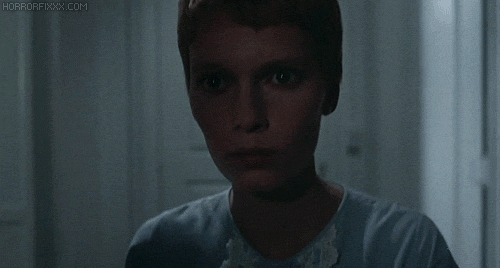Argento has no interest in realism whatsoever; Suspiria is
self-consciously stylized, and artificial. Suspiria is about intense color as
much as it is about anything. Maitland McDonagh describes Argento’s colors as “aggressively
unnatural, perhaps like stained glass—saturated yellow and deep cobalt blue—perhaps
artificially limpid, glittering plane turquoise and green. And always red, rich
and clear” (McDonagh). Argento’s phantasmagoria goes for the exact opposite of
the usual vivid and colorful film, disrupting every inch of the way and
graphically visualizing the bodily violence and dismemberment, like a Grimm
fairytale...it is not “kool-aidesque”.
 This film is based around gothic spaces,
childhood fantasies of something horrific “out there” in the dark come true,
such as a room may be inexplicably full of sharp wire coils, a bat may suddenly
attack, and maggots may drop from the ceiling into your hair as if to suggest a
state of rotting within the house. There are themes of instability and disorientation
within the lusciousness and beauty of Argento's destabilized world. Throughout
the film we are held captive(well I really was) by every image—whether the
drive from the airport, a walk up or down the gilded school staircase, or a
subjective traveling shot through the red corridor of the dance school. The
audience experiences these aesthetically beautiful images more than the narrative
itself. McDonagh explains such criticisms: “Even allowing for the degree to which
narrative is made deliberately subordinate to
mise-en-scene, it must be conceded that Argento can be a sloppy writer”
(McDonagh). Each room of the school is highly ornamental, as are the film's other
gothic locales, such as the irises by Madame Blanc's desk, and the geometric stained
glass windows. Many frames have a painterly composition, with characters
positioned in doorways or mirror frames that set them apart graphically from
other characters. Indeed, spatial aesthetics connects to story when the key to
the narrative mystery turns out to be a reference to design and color, such as
the iris.
This film is based around gothic spaces,
childhood fantasies of something horrific “out there” in the dark come true,
such as a room may be inexplicably full of sharp wire coils, a bat may suddenly
attack, and maggots may drop from the ceiling into your hair as if to suggest a
state of rotting within the house. There are themes of instability and disorientation
within the lusciousness and beauty of Argento's destabilized world. Throughout
the film we are held captive(well I really was) by every image—whether the
drive from the airport, a walk up or down the gilded school staircase, or a
subjective traveling shot through the red corridor of the dance school. The
audience experiences these aesthetically beautiful images more than the narrative
itself. McDonagh explains such criticisms: “Even allowing for the degree to which
narrative is made deliberately subordinate to
mise-en-scene, it must be conceded that Argento can be a sloppy writer”
(McDonagh). Each room of the school is highly ornamental, as are the film's other
gothic locales, such as the irises by Madame Blanc's desk, and the geometric stained
glass windows. Many frames have a painterly composition, with characters
positioned in doorways or mirror frames that set them apart graphically from
other characters. Indeed, spatial aesthetics connects to story when the key to
the narrative mystery turns out to be a reference to design and color, such as
the iris.
The various murder scenes functions in two crucial ways: thematically
and stylistic. This early double-murder sequence is typical for the film, in
that our attention is drawn to graphics, such as the squares of the grid Pat is
stabbed against. Here and everywhere in the set decorations we see these
shapes, especially the first murder. In this first murder, the geometric orders
of angles with the random formlessness of bloodstains resemble nothing more
than an expressionist painter's messy, colorful pallet.
Even through Argento
creates a beautiful environment surrounding these brutal murders, he “murders
and main and splatters blood with abstract abandon” in a “hedonist” way (McDonagh).
This creation may be a reason why this film is a favorite with many people,
particularly women…we are all enthralled with the mise-en-scene. In the words
of McDonagh: “The imagery is bizarre, almost surreal…” (McDonagh). Personally,
I dislike slasher films especially scenes of brutal murder/gore involving a
woman. Why would we watch and enjoy voyeuristically viewing something like
that? Now that can be a never-ending debate that may never be answered. All I
know is that “the world of Dario Argento is one of twisted logic, rhapsodic
violence, [and] stylized excess…” (McDonagh).





